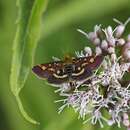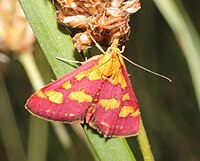pms
nòm ant ël fil


Der Purpurrote Zünsler (Pyrausta purpuralis) ist ein Schmetterling aus der Familie der Crambidae.
Der Purpurrote Zünsler erreicht eine Flügelspannweite von etwa 20 Millimetern. Die Vorderflügel sind mit purpurfarbenen Schuppen bedeckt und weisen mehrere goldgelbe Flecke auf. Die Hinterflügel besitzen eine schwärzliche Grundfärbung und tragen eine hellgelbe Binde. Je nach Alter des Falters kann die Färbung unterschiedlich stark ausgeprägt sein. Bei stark abgeflogenen Exemplaren sind die namensgebenden purpurroten Schuppen fast nicht mehr vorhanden. Die zweite Generation ist größer und trägt meist eine breitere gelbe Zeichnung.[1]
Die Raupen sind grün gefärbt und besitzen gelbliche Längslinien und einen braunen Kopf.
Zum Lebensraum gehören trockene bis feuchte Stellen in offenen Landschaften, zum Beispiel Wiesen und grasige Stellen.
Zu den Nahrungspflanzen der Raupen zählen u. a. Ackerminze (Mentha arvensis), Wasserminze (Mentha aquatica) und Dost (Origanum). Sie fressen in Bodennähe in zusammengesponnenen Blättern der Futterpflanzen.
Die Falter fliegen sowohl bei sonnigem Wetter als auch in der Dunkelheit.
Pyrausta purpuralis fliegt in zwei Generationen von April bis Juni und von Juni bis Mitte Oktober. Die Flugzeiten können sich in Abhängigkeit von den klimatischen Bedingungen verschieben. Die Raupen können von Mai bis Juni und im August bzw. im April des folgenden Jahres beobachtet werden. Die Art überwintert als Raupe.
Pyrausta purpuralis ist in Europa weit verbreitet.[2][3] Die Art ist auch auf den Britischen Inseln vertreten.
In der Literatur gibt es folgende Synonyme:
Der Purpurrote Zünsler (Pyrausta purpuralis) ist ein Schmetterling aus der Familie der Crambidae.
Pyrausta purpuralis is a species of moth of the family Crambidae. It was described by Carl Linnaeus in his 1758 10th edition of Systema Naturae and is found in Europe. The species closely resembles Pyrausta aurata and Pyrausta ostrinalis. It is also known by the common name Common Purple & Gold.
The wingspan is about 20 mm. The forewings are purple, more or less mixed with dark grey; markings ochreous yellow, black-edged; an oblique fascia near base, not reaching costa; a spot in middle of disc; an irregular postmedian fascia, sometimes broken into three spots; sometimes a subterminal streak, not reaching apex. Hindwings are black, base sometimes suffused with whitish-ochreous; a discal spot and curved postmedian fascia whitish-ochreous; sometimes a whitish-ochreous subterminal streak, sometimes purple in middle. The larva is dark grey; dorsal and spiracular lines yellowish; spots black, whitish-edged.[1]
The moth flies from May to September depending on the location. The species is active during the day.
The larvae feed on mint.
Pyrausta purpuralis is a species of moth of the family Crambidae. It was described by Carl Linnaeus in his 1758 10th edition of Systema Naturae and is found in Europe. The species closely resembles Pyrausta aurata and Pyrausta ostrinalis. It is also known by the common name Common Purple & Gold.

The wingspan is about 20 mm. The forewings are purple, more or less mixed with dark grey; markings ochreous yellow, black-edged; an oblique fascia near base, not reaching costa; a spot in middle of disc; an irregular postmedian fascia, sometimes broken into three spots; sometimes a subterminal streak, not reaching apex. Hindwings are black, base sometimes suffused with whitish-ochreous; a discal spot and curved postmedian fascia whitish-ochreous; sometimes a whitish-ochreous subterminal streak, sometimes purple in middle. The larva is dark grey; dorsal and spiracular lines yellowish; spots black, whitish-edged.
The moth flies from May to September depending on the location. The species is active during the day.
The larvae feed on mint.
Pyrausta purpuralis, la Pyrale pourprée ou Pyrauste pourprée, est une espèce de lépidoptères (papillons) de la famille des Crambidae et du genre Pyrausta.
Pyrausta purpuralis, la Pyrale pourprée ou Pyrauste pourprée, est une espèce de lépidoptères (papillons) de la famille des Crambidae et du genre Pyrausta.
Het purpermotje (Pyrausta purpuralis) is een vlinder uit de familie grasmotten (Crambidae).
De vlinder lijkt sterk op het muntvlindertje (Pyrausta aurata) maar bezit andere kenmerken zoals een meer witte band over de ondervleugel, waarboven nog een kleinere smallere band loopt. Aan de hand van de bovenvleugels is het onderscheid niet goed te maken. Beide hebben ze munt als waardplant. De vliegtijd van de purpermot is van mei tot en met september. Het is in Nederland een zeldzame soort en in België tamelijk schaars.
Het purpermotje (Pyrausta purpuralis) is een vlinder uit de familie grasmotten (Crambidae).
De vlinder lijkt sterk op het muntvlindertje (Pyrausta aurata) maar bezit andere kenmerken zoals een meer witte band over de ondervleugel, waarboven nog een kleinere smallere band loopt. Aan de hand van de bovenvleugels is het onderscheid niet goed te maken. Beide hebben ze munt als waardplant. De vliegtijd van de purpermot is van mei tot en met september. Het is in Nederland een zeldzame soort en in België tamelijk schaars.
Pyrausta purpuralis é uma espécie de insetos lepidópteros, mais especificamente de traças, pertencente à família Crambidae.[1]
A autoridade científica da espécie é Linnaeus, tendo sido descrita no ano de 1758.
Trata-se de uma espécie presente no território português.
Pyrausta purpuralis é uma espécie de insetos lepidópteros, mais especificamente de traças, pertencente à família Crambidae.
A autoridade científica da espécie é Linnaeus, tendo sido descrita no ano de 1758.
Trata-se de uma espécie presente no território português.
Pyrausta purpuralis là một loài bướm đêm thuộc họ Crambidae. Nó được tìm thấy ở châu Âu. The species closely resembles Pyrausta aurata.
Sải cánh dài ca. 20 mm. Con trưởng thành bay từ tháng 5 đến tháng 9 tùy theo địa điểm. The species is active during the day.
Pyrausta purpuralis là một loài bướm đêm thuộc họ Crambidae. Nó được tìm thấy ở châu Âu. The species closely resembles Pyrausta aurata.

Sải cánh dài ca. 20 mm. Con trưởng thành bay từ tháng 5 đến tháng 9 tùy theo địa điểm. The species is active during the day.